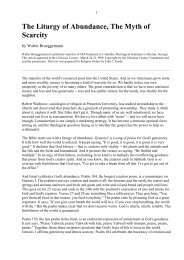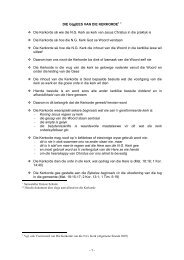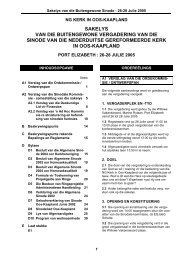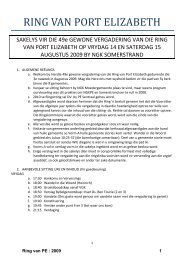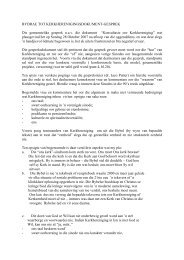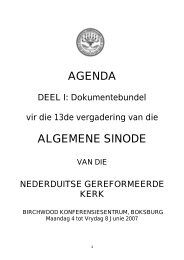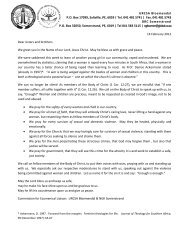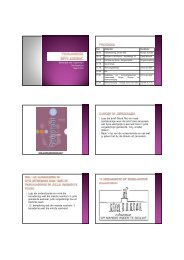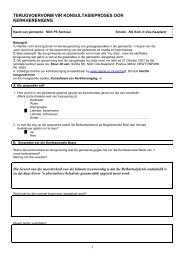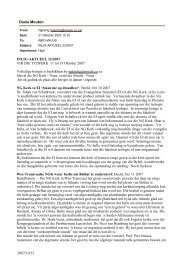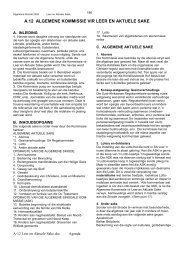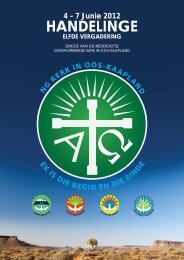BelharBelydenis - NG Kerk in Oos-Kaapland
BelharBelydenis - NG Kerk in Oos-Kaapland
BelharBelydenis - NG Kerk in Oos-Kaapland
You also want an ePaper? Increase the reach of your titles
YUMPU automatically turns print PDFs into web optimized ePapers that Google loves.
Artikel 2<br />
Ons glo aan een, heilige, algemene,<br />
Christelike kerk, die gemeenskap van die<br />
heiliges, geroepe uit die ganse menslike<br />
geslag.<br />
Hierdie is ‘n direkte aanhal<strong>in</strong>g van die<br />
“merktekens” van die kerk soos <strong>in</strong> Nicea en<br />
die Twalf Artikels bely, en <strong>in</strong> <strong>NG</strong>B art 27<br />
bevestig word. Die byvoeg<strong>in</strong>g van geroepe<br />
uit die ganse menslike geslag is oorgeneem<br />
uit HK vr en antw 54 waar hierdie belydenis<br />
verduidelik word. Alhoewel waarskynlik nie<br />
presies so bedoel nie, sou ons die drie<br />
middelste artikels van die belydenis kon<br />
verb<strong>in</strong>d aan die eenheid (art 2), heiligheid<br />
(art 3) en Christelikheid (art 4) van die kerk,<br />
met die eerste en laaste artikels wat op na<br />
die algemeenheid van die kerk verwys.<br />
Belhar is deur en deur ‘n kerklike belydenis<br />
-‘n belydenis van en oor die kerk, begrond <strong>in</strong><br />
die belydenis oor God.<br />
Ef 2: 11-22<br />
Ons glo dat die versoen<strong>in</strong>gswerk van<br />
Christus sigbaar word <strong>in</strong> die kerk as<br />
geloofsgemeenskap van diegene wat met<br />
God en onderl<strong>in</strong>g met mekaar versoen is;<br />
Hierdie artikel laat val die klem op die<br />
sigbare (sienbare) eenheid van die kerk. Die<br />
sigbare eenheid hang nie af van hoeveel<br />
mense van mekaar hou nie: Dit groei uit die<br />
werk van Christus wat mense met God en<br />
met mekaar versoen. Die verwys<strong>in</strong>g na Efe<br />
2:11-22 plaas klem daarop dat dit hier juis<br />
gaan om mense wat gewoonlik vyande van<br />
mekaar is (Jode en nie-Jode, besnedenes<br />
en onbesnedenes). Hulle word volgens die<br />
Bybel deur hul eenheid met Christus Jesus<br />
nou “tot een nuwe mensheid verenig”. Dit<br />
het die prys van Christus se liggaam, dood<br />
en kruis gekos om hierdie vrede tot stand te<br />
br<strong>in</strong>g (Efe 2:16-17).<br />
Ef 4: 1-16<br />
dat die eenheid van die kerk van Jesus<br />
Christus daarom gawe én opdrag is; dat<br />
dit 'n sameb<strong>in</strong>dende krag is deur die<br />
werk<strong>in</strong>g van Gods Gees, maar<br />
terselfdertyd 'n werklikheid is wat<br />
nagejaag en gesoek moet word en<br />
waartoe die volk van God voortdurend<br />
opgebou moet word;<br />
Hierdie sigbare eenheid het ‘n twee kante:<br />
Aan die een kant is dit ‘n geskenk van die<br />
Heilige Gees, en gebou op die eenheid van<br />
en <strong>in</strong> God (Efe 4:4-6). Maar terselfdertyd is<br />
dit ‘n roep<strong>in</strong>g (Efe 4:4) en iets waarop die<br />
kerk haar moet toelê (Efe 4:3). Eenheid is<br />
nie ‘n opsionele ekstra op die agenda van<br />
die kerk waaraan mense maar by tye<br />
aandag gee nie: Dit behoort tot die wese en<br />
kernopdrag van die kerk. ‘n “Onenige kerk”<br />
is strydig met die bedoel<strong>in</strong>g van God vir die<br />
kerk.<br />
Rom 12:3-8; 1 Kor 12:1-11; Ef 4:7-13; Gal<br />
3:27-28; Jak 2:1-13<br />
dat hierdie eenheid <strong>in</strong> vryheid gestalte<br />
kan v<strong>in</strong>d en nie onder dwang nie;<br />
Die Bybeldele wat Belhar hier aanhaal, kom<br />
almal uit die “etiese” dele van die briewe en<br />
uit die wysheid van Jakobus. Dit verklaar<br />
wat die belydenis e<strong>in</strong>tlik wil sê: Dis alleen<br />
op grond van die genade (Rom 12), en op<br />
Belydenis van Belhar ● Belhar Confession ● Isivumo SaseBelhar<br />
Article 2<br />
We believe <strong>in</strong> one holy, universal<br />
Christian Church, the communion of<br />
sa<strong>in</strong>ts called from the entire human<br />
family<br />
This is a direct quotation of the “signs” of the<br />
church as confessed <strong>in</strong> Nicea and the<br />
Twelve Articles, and is confirmed <strong>in</strong> the DCF<br />
article 27. The addition of gathered out of<br />
the whole human race is taken from the HC<br />
question and answer 54 that expla<strong>in</strong>s this<br />
confession. Although it is not meant<br />
precisely to be so, we can relate the three<br />
middle articles of the Confession with the<br />
unity (art 2), hol<strong>in</strong>ess (art 3) and the<br />
Christianity (art 4) of the church, with the<br />
first and last articles that refer to the<br />
universality of the church. Belhar is a<br />
confession of the church, <strong>in</strong> the deepest<br />
sense – a confession of and about the<br />
church, rooted <strong>in</strong> the confession about God.<br />
Eph 2:11 – 22<br />
We believe that Christ’s work of<br />
reconciliation is made manifest <strong>in</strong> the<br />
Church as the community of believers<br />
who have been reconciled with God and<br />
with one another;<br />
This article emphasises the visible (to be<br />
seen) unity of the church. The visible unity<br />
does not depend on how much people like<br />
each other. It grows from the work of Christ<br />
who reconciles people with God and with<br />
each other. The reference to Eph 2:11 – 22<br />
emphasises that this concerns people who<br />
are often enemies (Jews and Gentiles,<br />
circumcised and uncircumcised). Accord<strong>in</strong>g<br />
to the Bible they are now “reconciled <strong>in</strong> one<br />
body” through the cross of Jesus Christ.<br />
The cost for accomplish<strong>in</strong>g this peace was<br />
Christ’s body and his death on the cross<br />
(Eph 2: 16-17).<br />
Eph 4: 1-16<br />
that unity is, therefore, both a gift and an<br />
obligation for the Church of Jesus<br />
Christ; that through the work<strong>in</strong>g of<br />
God’s Spirit it is a b<strong>in</strong>d<strong>in</strong>g force, yet<br />
simultaneously a reality which must be<br />
earnestly pursued and sought; one<br />
which the people of God must<br />
cont<strong>in</strong>ually be built up to atta<strong>in</strong>;<br />
This visible unity has two sides: On the one<br />
side it is a gift of the Holy Spirit, and built on<br />
the unity of and <strong>in</strong> God (Eph 4: 4-6). But at<br />
the same time it is a mission (Eph 4:4) and a<br />
task to which the church should apply<br />
herself (Eph 4:3) Unity is not an optional<br />
extra on the agenda of the church that<br />
people could attend only now and then. It<br />
belongs to the very nature and core of the<br />
church’s commission. A ‘disunited church’<br />
is <strong>in</strong> conflict with what God <strong>in</strong>tended for the<br />
church.<br />
Ro 12; 3-8; 1 Co12: 1-11; Eph 4; 7-13; Ga<br />
3: 27-28; Jas 1: 1-13<br />
That this unity can be established only <strong>in</strong><br />
freedom and not under constra<strong>in</strong>t;<br />
All parts of the Bible quoted here are from<br />
the “ethical” parts of the letters and from the<br />
wisdom of James. It expla<strong>in</strong>s what the<br />
confession really wish to say: It is only by<br />
reason of the grace given to us (Rom 12),<br />
8<br />
Isiqendu 2<br />
Siyakholwa kwicawe enye eNgcwele<br />
eyeyezizukulwana ngezizukulwana,<br />
ibubudlelane babaNgcwele ababiziweyo<br />
bevela kuluntu xa lulonke.<br />
Oku kucatshulwe njengoko kunjalo<br />
“kwiziphawuli” zeCawe ez<strong>in</strong>gq<strong>in</strong>wa kwisivumolukholo<br />
saseNicea nakwisivumo-sokholo<br />
sabaPostile (iziqendu ezilishumi el<strong>in</strong>esib<strong>in</strong>i),<br />
nanjengoko kungq<strong>in</strong>wa kwisivumo-lukhoko<br />
saseNetherlands (<strong>NG</strong>B) isiqendu 27. Ufakelo<br />
“bevela kuluntu xa lulonke” kuthatyathwe<br />
kwikhathikhezi yaseHeidelberg umbuzo<br />
nempendulo 54 apho esi sivumo-lukholo sicaca<br />
khona. Naxa kungathethwa njalo,<br />
s<strong>in</strong>gazidibanisa iziqendu ez<strong>in</strong>tathu eziphakathi<br />
zesivumo kubunye (isqendu 2)<br />
KuNgcwele (isiqendu 3) kunye nobuKrestu<br />
(isiqendu 4) beCawe kunye neziqendu zokuqala<br />
nezokugqibela ezigqithiselwa kwiCawe<br />
ngokubanzi. Isivumo-lukholo saseBelhar<br />
s<strong>in</strong>gesivumo seCawe, isivumo es<strong>in</strong>gecawe,<br />
esisekelwe kwisivumo es<strong>in</strong>goThixo<br />
Kwabase-Efese 2:11-22<br />
Siyakholwa ukuba umsebenzi kaKrestu<br />
wokuxolelanisa uyabonakale kuleCawe<br />
ububudlelane nokholo babo bathe<br />
baxolelwaniswa noThixo nabathe<br />
baxolelaniswa omnye nomnye.<br />
Esi siqendu sigx<strong>in</strong><strong>in</strong>isa kubunye obubonakalayo<br />
necawe. Ubunye obubonakalayo<br />
abuxhomekekanga kubungakanani babantu<br />
abathandanayo. Bukhula kumsebenzi kaKrestu<br />
oxolelenisa abantu kunyenoThixo, umntu kunye<br />
nomnye. Isalathiso saKwabase-Efese 2:11-22<br />
kungx<strong>in</strong><strong>in</strong>isa oko kanye, ukuba abantu kanye<br />
abazi<strong>in</strong>tshaba omnye komnye (amYuda nabo<br />
bengengawo abolukileyo nabo bangalukile).<br />
NgokweBhayibhile bamanywa nobunye babo<br />
noKrestu “kubunye obutsha bobuntu ibe<br />
lixabiso lomzimba kaKrestu, ukufa kwakhe<br />
nomnqamlezo wakhe owenza ukuba olu xolo<br />
lube nokuma (kwabase-Efese 2:16-17).<br />
Kwabase-Efese 4:1-16<br />
Ngenxa yoko siyakholwa ukuba ubunye<br />
beCawe kaYesu Krestu busisiphiwo,<br />
bukwangumyalelo; bungamandla<br />
abandakanyayo ngomsebenzi kaMoya<br />
oyiNgcwele, kodwa kananjalo buy<strong>in</strong>to<br />
ekufuneka iphuthunywe, ifunwe <strong>in</strong>to<br />
ekufanele ukuba abantu bakaThixo bahlale<br />
bekhuthazwa ukuyakha.<br />
Obu bunye bubonakalayo bunamacala amab<strong>in</strong>i:<br />
Kwel<strong>in</strong>ye icala busisisphiwo soMoya<br />
oyiNgcwele, kwaye busekelwe phezu kobunye<br />
bukaThixo nobukuThixo (Kwabase-Efese 4:4-<br />
6). Kodwa kwangaxesha –nye ikwalubizo<br />
(kwabase-Efese 4:4) kwaye iy<strong>in</strong>to apho iCawe<br />
kufuneka iyizamile (kwabase-Efese 4:3).<br />
Ubunye asiyonto nje eyodwa ekho kumgaqonkqubo<br />
weCawe, apho abantu kubakho<br />
amaxesha athile abayiqwalaselayo: Kufuneka<br />
ibe ngumyalelo osisiseko seCawe “Icawe<br />
engaq<strong>in</strong>isekanga” ichasene nenjongo kaThixo<br />
ngeCawe yakhe.<br />
KwabaseRoma 12:3-8;1 Kor. 12:1-11;<br />
Kwabase-Efese 4:7-13; KumaGalati 3:27-28;<br />
Yak. 2:1-13<br />
Okokuba obu bunye bunokuphumeleliswa<br />
kuphela kukuqhutywa y<strong>in</strong>tlliziyo kungekho<br />
ngokunyanzelwa;<br />
Izicatshulwa zeBhayibhile ezicatshulwe apha



